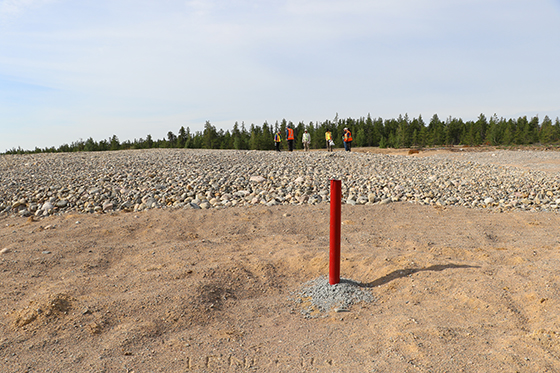Bullmoose-Ruth Remediation Project
On this page
Overview
The following seven contaminated sites were remediated as part of a single remediation contract, due to their close proximity to one another: Bullmoose Mine, Ruth Mine, Storm Mine, Joon Mine, Beaulieu Mine, Spectrum Lake Mine, and Chipp Lake Mine. These sites are located between 70 and 90 km east of Yellowknife. Operations at these sites, including gold exploration and mining, occurred intermittently between the 1940s and the 1980s.

What work has been done?
| 2009 | Site investigations were carried out at Bullmoose Mine and Ruth Mine. |
| 2010 | Crown-Indigenous Relations and Northern Affairs Canada (CIRNAC) provided an overview of the contamination at the Bullmoose-Ruth mines to the Yellowknives Dene First Nation (YKDFN) Chief and council, and explained the ways in which the YKDFN could participate in the remediation project. Community members and Elders were invited on a site tour to view the former mine sites. This allowed members to better understand the remediation activities required. A Traditional Dene Land Use Study was completed to investigate how the mine sites were traditionally used by the Dene and how they have been used since the mine sites were established. Site investigations were carried out at all seven sites and fencing was put up around the deteriorating headframe at Ruth Mine. |
| 2011 | Site specific risk assessments were completed at Bullmoose, Ruth, Beaulieu and Spectrum Mines. Signs warning of deteriorating buildings and other hazards were posted at Spectrum Mine. A Draft Remedial Action Plan was developed for all seven sites. This plan was developed through engagement and Remedial Options Workouts with the YKDFN, Lutsel K'e Dene First Nation (LKDFN), Deninu Kue First Nation (DKFN) and the Fort Resolution Métis Counci (FRMC) to discuss potential remediation options for the mine sites. |
| 2012 | Additional fieldwork was conducted to finalize remedial options for the sites. |
| 2014 | Additional fieldwork was conducted to assess impacts from the 2014 wildfires, in which the Ruth mine site was completely burned over, and to confirm borrow source locations and volumes of identified sources near the airstrip. |
| 2015 | As members of the Waste Site Management Committee (WSMC), CIRNAC and the Government of the Northwest Territories (GNWT) met with signatories to the NWT Devolution Agreement to discuss how waste sites are cared for and remediated in the NWT. Revised remedial options for all sites were selected with the YKDFN and the revised Remedial Action Plan (RAP) was finalized. A Site Wide Hazard Assessment was conducted to identify site hazards to workers who will be completing the remediation work. A community meeting was held in Ndilǫ to provide the community with up-to-date information. A borrow source investigation was conducted to determine how much borrow material is available at the Bullmoose site airstrip. A bidder's tour was conducted in September in preparation for procurement. This allowed potential contractors to view the scope of the project first-hand. |
| 2016 | CIRNAC met with Tłı̨chǫ Department of Culture and Lands Protection representatives, community members, elders, and Wek'eezhii Land and Water Board (WLWB) representatives to provide an update of remediation activities in the Tłı̨chǫ and Akaitcho Regions. Archaeological surveys of all sites were carried out in August to document areas and items of cultural significance. The remediation project was tendered on buyandsell.gc.ca from May to June. A User Group Meeting was held in July to inform users of activities completed to date, as well as upcoming activities on the sites and the controls in place to mitigate risk. Notified users include cabin owners, lodge owners, and mineral lease holders. An information package was sent to this user group following the meeting. The remediation contract was awarded to Rowe's-Outcome Joint Venture (ROJV) in August. This contract was valued at $ 15.6M A Community Meeting on August 30th provided an opportunity for Rowe's-Outcome Joint Venture to outline their plans for remediation of the sites and upcoming socio-economic opportunities. ROJV completed site and winter road track surveys in September. Two site tours and blessings took place in September. Participants include Akaitcho Dene and Métis Elders and community members as well as members of the Mackenzie Valley Land and Water Board (MVLWB). ROJV completed non-hazardous waste cleanup at Chipp and Storm sites in September. A Type A Land Use Permit and a Type B Water Licence were issued by the Mackenzie Valley Land and Water Board in December. |
| 2017 | ROJV conducted pre-construction of the winter road including brush clearing of portages and mobilized equipment to site. Remediation started on all sites in April. Canada brought in community members and Elders to tour the sites, see the progress in person, and provide input on design alterations. |
| 2018 | Winter road construction with site re-supply and hazardous waste back haul. Completion of remediation activities. |
What's next?
| The project will now move into closure and monitoring phase. |
More information
The abandoned mine sites are situated on land that has been traditionally used and occupied by the Akaitcho Dene and North Slave Métis. Many of the structures on these sites were destroyed by forest fires in 2014; however, there are remaining residual risks and known physical hazards that will be addressed through remediation.
Remediation included cleaning up petroleum hydrocarbon contamination, waste rock, and tailings and soils with metal contamination. It also included mitigating physical hazards such as debris and mine shaft openings.
The full scope of the work required is outlined in the Remedial Action Plan, available on the Mackenzie Valley Land and Water Board's Public Registry. The remediation of these sites was completed by Rowe's-Outcome Joint Venture.
CIRNAC is committed to continuing to engage with local communities to inform the remediation process. Read the Community Engagement Plan for the Bullmoose-Ruth Remediation Project (last updated December, 2016) for more information.